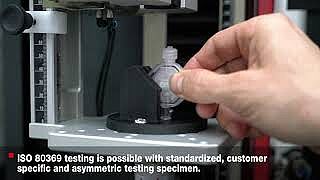Collaborative Effort in Ulm Develops a Semi-Automatic Test on Small Bore Luer Connectors to ISO 80369-7/ISO 80369-20
Small bore Luer connectors are important components of many medical devices such as tubes, syringes and other consumables which supply fluids and gases in clinical practice.
The ISO 80369 standard series was developed to avoid accidental misconnections between different medical connectors. The prevention of incorrect connections is achieved by specifying different types of connectors so that they are intentionally dimensionally incompatible.
Performance test to ISO 80369-7 and ISO 80369-20
In addition to preventing incorrect connections, the ISO 80369 standard series establishes performance specifications regarding unintentional disconnections or leaks.
For the performance test, the small bore connector must first be assembled with a standardized reference connector under a pre-defined axial load and a pre-defined torque. This assembly is then subjected to the above leakage or loosening tests, during which a specific amount of pressure, a specific force, or a specific torque is applied for a specified amount of time. The connector is classified as “Pass” if no leakage or loosening of the connection is detected.
The performance tests are normally conducted with specially developed testing instruments. As is the case with the majority of these instruments that are in use today, the previous equipment used by SpineServ consisted of a manually operated load frame and dead weights that are positioned to apply the required forces and torques. In most cases, assembly and testing had to be performed with different equipment, so the assembly had to be removed from the mounting unit and newly mounted in the test fixture. SpineServ was able to show that such manipulation of the test assembly, even if done very carefully, can have systematic and unsystematic effects on the test results. With the use of such instruments, the traceability of the results is limited and the risk of undetected operating errors is relatively high. Therefore, SpineServ defined internal requirements to improve the quality of their tests.
To combine the existing knowledge and experience in and around Ulm, SpineServ and ZwickRoell established an “Ulm Collaborative Effort”. The goal was to develop a testing system that fully met the ISO 80369 standard series requirements and makes it possible to perform semi-automatic and traceable all-in-one testing on small bore connectors.
The task of SpineServ as an experienced and internationally accredited service provider for testing medical devices was to provide their application-related expertise.
Technically, the new testing system is based on a zwickiLine standard testing machine with torsion drive. This machine is equipped with 200 N and 2 Nm load sensors. Pneumatic grips are attached on the base plate of the machine. This is where the connector is gripped. The reference connector is attached to the axial drive and connected to pneumatic lines for pressure decay and subatmospheric air pressure leakage tests.
Test arrangement
Basic hardware components at the interface between machine and connector of the new testing system for small bore Luer connectors to ISO 80369 that resulted from the “Ulm Collaborative Effort” between ZwickRoell and SpineServ.
1 Reference connector
2 Connector to be tested (in this case a syringe)
3 Pneumatic line for leak tests
4 Pneumatic grips to secure the connector to be tested
5 Torque transducer
6 Torsion drive
The test to ISO 80369-7 and ISO 80369-20
The complete system works with the testXpert III testing software. The specially developed master test method for ISO 80369 makes it possible to select one of the following standard performance tests:
- Leakage by pressure decay test method
- Falling drop positive-pressure liquid leakage test method
- Subatmospheric pressure air leakage test method
- Stress cracking test method
- Resistance to separation from the axial load test method
- Resistance to separation from unscrewing test method
- Resistance to overriding test method
- Disconnection by unscrewing test method
All data (forces, displacements, torques, angles, pressure) is recorded and is therefore traceable for each individual connector. Furthermore, the specimens do not have to be removed from the system after assembly, except for the drop test, which requires horizontal alignment for testing. The only step during the test process in which the operator has to intervene manually is the step "Positioning and aligning the specimen". At this stage, relevant experience is required to ensure that the specimen is properly aligned and sufficiently secured, while preventing deformation of the specimen at the same time. All other steps are performed automatically.
SpineServ has been working with the latest version of the testing system for several months. Numerous tests on different connection types have shown that the above-mentioned traceability requirements, a lower need for manual intervention (all-in-one), and a minimized risk of operational errors are fully met. Additionally, the specimen throughput was able to be increased significantly. For an accredited test laboratory such as SpineServ, these features of the new testing system, combined with the relevant experience in testing medical devices, are unique prerequisites for time-efficient, high-quality tests of small bore Luer connectors.
